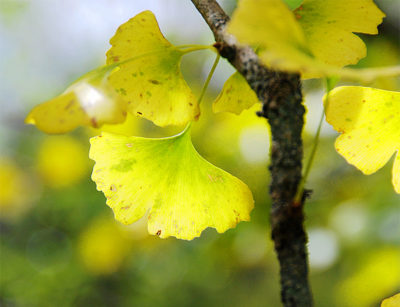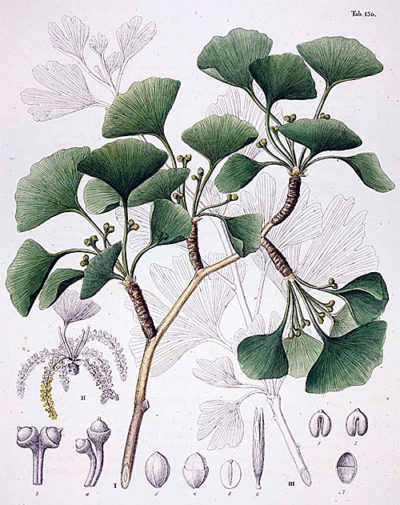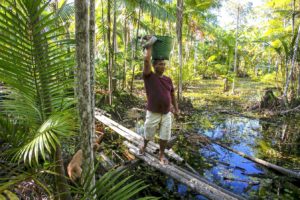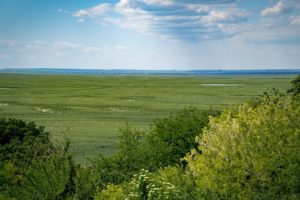Millions of urban dwellers know the ginkgo primarily as a street tree, with elegant, fan-shaped leaves, foul-smelling fruits, and nuts prized for their reputed medicinal properties. But botanist Peter Crane sees the ginkgo as much more — an oddity in nature because it is a single species with no known living relatives; a living fossil that has been essentially unchanged for more than 200 million years; and an inspiring example of how humans can help a species survive.
Crane, who is dean of the Yale School of Forestry & Environmental Studies, has written what he describes as a biography of the oldest tree on earth, a living link to the age of the dinosaurs. His new book, Ginkgo, tells the story of a tree that over centuries has made its way from China across Asia and around the world and today is found along streets everywhere from Seoul to New York.
In an interview with Yale Environment 360, Crane explains what makes the ginkgo unique and what makes it smell, how its toughness and resilience has enabled it to thrive, and what the tree’s long history says about human life on earth. The ginkgo, which co-existed with the dinosaurs, “really puts our own species — let alone our individual existence — into a broader context,” says Crane.
Yale Environment 360: You’ve been studying ginkgo trees for a long time. How did you come to develop an interest in them?
Peter Crane: I think that anyone who is seriously interested in plants inevitably comes across ginkgo pretty early in their training, because there are only five living groups of seed plants, and ginkgo is one of them. And ginkgo is the only one that consists of just one species. So it’s an important plant in any botanist’s view of the plant world — you inevitably run across it early in your training. The other thing is that it has such a distinctive leaf — once you see it, you don’t forget it. It’s thoroughly memorable.
e360: You’ve mentioned that ginkgo is something of a biological oddity in that it’s a single species with no living relatives. That’s somewhat unusual in the plant and animal world, isn’t it?
Crane: Yes. When we think about flowering plants, there are about 350,000 living species. And in an evolutionary sense, they’re equivalent to that one species of ginkgo. They’re all more closely related to each other than they are to anything else. But the ginkgo is solitary and unique, not very obviously related to any living plant. One of the points I wanted to draw out in the book is that in the past there were a variety of ginkgo-like plants, but this is the only one surviving.
e360: You describe the ginkgo as a “living fossil,” in the sense that in many ways it’s unchanged in more than 200 million years. How do we know that?
Crane: If you look at fossils from more than 200 million years ago, you can see leaves that are very very similar to modern ginkgo leaves. But you have to look more closely to really assess whether those leaves were produced by plants that are identical to modern ginkgo. And that work has been done now, by my colleague [Chinese paleobotanist] Zhou Zhiyan, who has worked on fossil material from China. And what he’s noticed is that there are some differences in the ways that the seeds are attached in these fossil plants — but in the grand scheme of things, they’re not very different.
With the fossils that I’ve worked on myself, from about 65 million years ago, we were able to determine exactly how the seeds were attached to the plant, and they were attached in an identical way to modern ginkgo. If we could go back in a time machine, maybe we would find some differences, but I suspect not.
e360: And the oldest fossil record?
Crane: A little over 200 million years old. So it is a good example of a living fossil, like the coelacanth, which has also changed very little over millions of years.
e360: Most of us know ginkgo from its very distinctive, fan-shaped leaves, and also from its very distinctive smell. What is with the smell?
Crane: It’s the outer part of the seed that produces the smell, and it smells, to put it bluntly, like vomit. More than likely, it reflects some sort of adaptation or modification in its dispersal biology. Probably either now or in the past the smell has been attractive to animals. You hear stories of dogs, for example, eating ginkgo seeds — sometimes with not a terribly happy outcome in that they don’t feel so good afterward. But it must be part of a dispersal system. The interesting question is, are the things that adapted to disperse it still around? Or are they extinct?
There’s this wonderful idea that [Daniel] Janzen and [Paul] Martin published about how many neo-tropical fruits don’t appear to have any dispersers in the contemporary fauna. And their idea was that as many large mammals went extinct about 10,000 years ago, many plants actually lost their most important dispersal agents. So in a sense, the plants have continued to live on, while the dispersers themselves have already gone extinct.
e360: So their theory would say that the ginkgo smell would have attracted dinosaurs to eat it?
Crane: Yes, or more likely some mammals that died out much more recently. But the idea is that the tree now could be out of phase with its dispersal agents. There are records of the seeds being eaten by badgers and so on, and as I talk to people it’s clear that the seeds do still move around. So something’s moving them. And you know, the seeds are very attractive — once that smell’s gone, they look a bit like a pistachio. And they have a nice nutritious meat in them, so they would attract animals like squirrels.
e360: When are the seeds on the ground? Is that the late fall?
Crane: They’re usually on the ground in the late fall here in temperate North America. So the trees are dropping their seeds in late November, December. And then often, what saves us from the smell is that they all freeze.
e360: When was the ginkgo first cultivated by humans?
Crane: Our best estimate is about 1,000 years ago in China, which is somewhat late for the cultivation of many plants in China. There’s a lot of Chinese literature from before 1,000 years ago, and it doesn’t mention ginkgo, while it does mention a lot of other plants. The evidence points to the fact that ginkgo was probably always a rather rare tree, and that it first attracted the attention of people about a thousand years ago. Probably originally as a nut — a rather unusual nut tree. And then it was moved around and grown for its nuts in China, before eventually — maybe in the 14th or 15th centuries — making its way up the coastal trade routes into Korea and Japan.
e360: And how and when did it appear in the West?
Crane: The first Westerner to encounter ginkgo — or at least the first Westerner to encounter it and write about it — was Engelbert Kaempfer, who was with the Dutch East India Company at their trading station in southern Japan in 1692. When he returned, he wrote his account of his time in Japan. He is the one who first uses the word in the Western literature — ginkgo — and he provides an illustration of it. But probably living plants weren’t introduced into Europe until a few decades after that — perhaps in the 1730s, but I think more likely in the 1750s.
e360: Ginkgoes have long been valued for their healing properties, their medicinal properties, particularly for helping memory. And we see today ginkgo being sold pretty widely in health food stores. Did the medicinal use of ginkgo emerge in China, and if so, how recent is its move to the West?
Crane: That’s a very interesting question, because if you look and see how ginkgo is used medicinally in China, it’s mainly the seeds that are used. Yet, the Ginkgo biloba that you buy in health food stores here is an extract of the leaves. And this is pretty much a Western phenomenon. So this is a use that we’ve invented for it in the West, rather than a use that has come to us from China. The medicinal uses in the East and the supposed medicinal uses in the West have gone in different directions, using two different parts of the plant — mainly the seeds in the East, and mainly the leaves in the West.
e360: Are there any scientific studies that looked at the efficacy of the medicinal properties, like for memory enhancement — either for the leaves or the seeds?
Crane: The most work’s been done on the leaves in the West. And I think it’s true to say the results are equivocal. I don’t think there’s really strong evidence for its efficacy, but on the other hand, there are conflicting results. There’s some evidence that it’s helpful in some ways, but the large-scale trials that we expect from our drugs these days have been unable to be really definitive about that. It’s a bit of an enigma in that respect — it’s difficult to prove its value.
e360: You write in the book about how the ginkgo’s resilience has enabled it to become quite a popular street tree — it can take a lot of abuse. What makes the ginkgo so resilient as a tree?
Crane: It’s hard to put a finger on what exactly does it. But the leaves are particularly unattractive to pests, so it doesn’t suffer from the pest problems that some trees do. And it seems to survive in a street setting: its roots aren’t getting much oxygen, they’re getting a lot of salt and goodness knows what else is getting poured on them, and it seems relatively resistant to those problems. So it’s just a good old tough tree, and it is incredibly widely planted.
e360: How widely, and in what places is it most common?
Crane: Well, it’s particularly widespread in the East: you see it all over Tokyo, you see it all over Seoul. But you also see it all over Manhattan. Once you start to recognize ginkgo trees in the urban landscape, you start to see them everywhere.
e360: You mentioned in the book that the female seeds are the ones that smell. In New York City, the parks department has a policy of planting only males?
Crane: Yes. I think today most people would plant males. Most reputable nurseries will sell only males.
e360: One of the things you get into in the book is the broader discussion of the importance of street trees. One of the benefits, which I had never thought about before, is how trees along a street make it feel narrower and cause drivers to go more slowly. It makes sense, but I had never thought of it. Can you describe some of the other benefits that street trees bring to a city or an urban setting?
Crane: I think most obviously they help reduce the urban heat island effect. They provide shade; they make the place a lot more comfortable. But I think there are a lot of intangible benefits too: people want to walk in the shade, they want to be out in the shade. And so trees create a less sterile environment and encourage people to want to be outside, with all the benefits that come from people being out and about — from having kids playing outside, to having neighbors keep an eye on each other’s houses, to encouraging people to linger in a shopping area that they would otherwise walk right through.
e360: You certainly see ginkgos everywhere, especially in New York City. You tell a story about a Harlem homeowner who has a ginkgo tree in front of her house and finds people in it regardless of the smell. Can you explain?
Crane: Yes, in many places where ginkgo is planted in the West, people who’ve known ginkgo or know about ginkgo through their cultural background, will often seek out the trees in the fall and collect the seeds. Particularly with people from Korea or China or Japan, it’s quite common. You see them in Central Park [in New York]. I’ve seen them in Chicago. You see them all over. And I’m sure none of those seeds are sold into commerce. I’m sure those seeds are used locally because people enjoy eating them. And sometimes people won’t wait for the seeds to fall. They’ll take sticks and bang them up into the branches to try to get the seeds to come down.
e360: I was surprised to learn from your book that the ginkgo nut is potentially toxic?
Crane: Yes, it does have some toxicity to it. It’s generally recommended that people don’t eat too many of these seeds. A small proportion of the population seems to have a bad reaction to ginkgo, but it’s a very small proportion. I’ve eaten ginkgo seeds many times.
e360: You actually have an ancient species of ginkgo, Ginkgo cranei, named after you, right?
Crane: Well, yes, that’s the fossil ginkgo from North Dakota that I worked on as a researcher, which a colleague quite recently very kindly named after me. But in a way it’ll be interesting to see if the name survives, because giving it a separate name implies that it’s actually different from modern ginkgo. And the study did point out a few very subtle differences. However, it remains to be seen whether those differences hold up. So I wouldn’t be surprised to see my name get synonymized back into Ginkgo biloba at some point.
e360: By distributing ginkgo around the planet, humans have, unlike with many other species, helped ensure the ginkgo’s survival. Is that the right way to look at it?
Crane: Yes, I think that’s right. I think by cultivating plants like ginkgo that are very rare in the wild, we’ve sort of taken out insurance for their long-term survival. In China, for a long time there was a lot of discussion about whether there were any native ginkgos at all, or whether all of them had the hand of people in their past. I think the consensus now is that probably a couple of wild, original populations still exist in China. But it’s very difficult to exclude the possibility that even those have been aided by people.
That is another message in the book. Obviously we should try to preserve animals and plants in their native habitats, where they’re part of a functioning integrated ecosystem. But in the same way that we’ve used ex situ methods for conserving large mammals, charismatic animals, I think conservation through cultivation is an important part of the toolkit for preserving plant diversity for the future.
e360: You’ve talked about how one of the things that drew you to learn more about the ginkgo was the sense of timelessness that its history gives you and how that helps us think about our place in the world.
Crane: Obviously, we’re evolved to live in the present, so we’re very focused on the short-term. One of our biggest shortcomings is that we can’t see the long-term, and we see that in the way we respond to all kinds of environmental issues. So reflecting on a plant like ginkgo that was around in very different ecosystems when the dinosaurs were on the planet, that has been around for hundreds of millions of years, really puts our own species — let alone our own individual existence — into a broader context.
It’s a bit like those diagrams that you see, where there’s a picture of the Milky Way and there’s a little sign that says, “You are here.” Well, it’s the same idea. Guess what? We’re not at the center of everything. And guess what? The universe doesn’t revolve around us. And guess what? We’re only here for a short time, whereas some things have been here for a really long time. That ought to encourage us to take the long view as we think about our relationship to the natural world.






